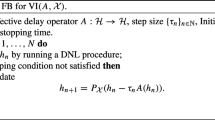Abstract
This paper recasts the Friesz et al. (1993) measure theoretic model of dynamic network user equibrium as a controlled variational inequality problem involving Riemann integrals. This restatement is done to make the model and its foundations accessible to a wider audience by removing the need to have a background in functional analysis. Our exposition is dependent on previously unavailable necessary conditions for optimal control problems with state-dependent time lags. These necessary conditions, derived in an Appendix, are employed to show that a particular variational inequality control problem has solutions that are dynamic network user equilibria. Our analysis also shows that use of proper flow propagation constraints obviates the need to explicitly employ the arc exit time functions that have complicated numerical implementations of the Friesz et al. (1993) model heretofore. We close by describing the computational implications of numerically determining dynamic user equilibria from formulations based on state-dependent time lags.
Similar content being viewed by others
References
Adamo, V., Astarita, V., Florian, M., Mahut, M. and Wu, L.J.H. (1998). “A Framework for Introducing Spillback in Link Based Dynamic Network Loading Models”. Presented at TRISTAN III, San Juan, Puerto Rico, June.
Astarita, V. (1995). “Flow Propagation description in Dynamic Network Loading Models.” Proc International Conference on Applications of Advanced Technologies in Transportation Engineering, 27–30 June, Capri, Italy.
Astarita, V. (1996). “A Continuous Time Link Model for Dynamic Network Loading Based on Travel Time Functions.” 13th International Symposium on Theory of Traffic Flow, Elsevier, New York.
Bernstein, D., Friesz, T.L., Tobin, R.L. and Wie, B.W. (1993). “A Variational Control Formulation of the Simultaneous Route and Departure-Time Equilibrium Problem.” Proceedings of the International Symposium on Transportation and Traffic Theory, Elsevier, New York, 107–126.
Carey, M. (1986). “A Constraint Qualification for a Dynamic Traffic Assignment Problem.” Transportation Science 20(1).
Carey, M. (1987). “Optimal Time-Varying Flows on Congested Networks.” Operation Research 35, 58–69.
Carey, M. (1992). “Nonconvexity of the Dynamic Traffic Assignment Problem.” Transportation Science 26B, 127–133.
Carey, M. (1995). “Dynamic Congestion Pricing and the Price of FIFO.” In N.H. Gartner and G. Improta (eds.), Urban Traffic Networks. Berlin: Springer-Verlag, pp. 333–350.
Daganzo, C.F. (1994). “The Cell Transmission Model, Part II, Netork Traffic.” Transportation Research 29B(2), 79–93.
Daganzo, C.F. (1995). “The Cell Transmission Model: A Simple Dynamic Representation of Highway Traffic.” Transportation Research 28B(4), 269–287.
Friesz, T.L. (1999). “Dynamic Traffic Assignment.” Transportation Modeling Handbook. Pergamon, forthcoming.
Friesz, T.L., D. Bernstein and R. Stough. (1996). “Variational Inequalities, Dynamical Systems and Control Theoretic Models for Predicting Time-Varying Urban Network Flows,” Transportation Science 30, 14–31.
Friesz, T.L., Luque, J., Tobin, R.L. and Wie, B.W. (1989). “Dynamic Network Traffic Assignment Considered as a Continuous Time Optimal Control Problem.” Operations Research 37, 893–901.
Friesz, T.L., Bernstein, D., Smith, T.E., Tobin, R.L. and Wie, B.W. (1993). “A Variational Inequality Formulation of the Dynamic Network User Equilibrium Problem.” Operations Research 41, 179–191.
Friesz, T.L., Suo, Z.-G., Bernstein, D., Tobin, R.L. and Wie, B.W. (1994). “A Variational Inequality Control Formulation of the Dynamic User Equilibrium Problem.” Working Paper 94–5, Network Analysis Laboratory, George Mason University.
Friesz, T.L., Tobin, R.L., Bernstein, D. and Suo, Z. (1995). Proper Flow Propagation Constraints which Obviate Exit Functions in Dynamic Traffic Assignment, presentation at INFORMS Spring National Meeting, Los Angeles, April 23–26.
Friesz, T.L., D. Bemstein, and R. Stough. (1996). “Dynamic Systems, Variational Inequalities and Control Theoretic Models for Predicting Time-Varying Urban Network Flows.” Transportation Science 30, 14–31.
Merchant, D.K. and Nemhauser, G.L. (1978a). “A Model and an Algorithm for the Dynamic Traffic Assignment Problems,” Transportation Science, Vol. 12,No.3, August 1978, pp. 183–199
Merchant, D.K. and Nemhauser, G.L. (1978b). “Optimality Conditions for a Dynamic Traffic Assignment Model.” Transportation Science, Vol.12,No.3, August 1978, pp. 200–207
Ran, B., D.E. Boyce, and L.J. LeBlanc. (1993). “A New Class of Instantaneous Dynamic User-Optimal Traffic Assignment Models.” Operations Research 41, 192–202.
Ran, B. and Boyce, D. (1996). Modeling Dynamic Transportation Networks, Springer-Verlag, Berlin.
Tobin, R.L. (1993). “Notes on Flow Propagation Constraints.” Working Paper 93–10, Network Analysis Laboratory, George Mason University.
Waller, S.T. and A.K. Ziliaskopoulos. (2001). “A Combinational User Optimal Dynamic Traffic Assignment Algorithm”, Submitted to Transportation Research Record
Wie, B.W., Friesz, T.L., et al. (1995). “A Discrete Time, Nested Cost Operator Approach to the Dynamic Network User Equilibrium Problem.” Transportation Science 29, 79–92.
Wu, J.H., Y. Cen, and M. Florian. (1998a). “The Continuous Dynamic Network Loading Problem: A Mathematical Formulation and Solution Method.” Transportation Research 32B, 173–187.
Wu, J.H., M. Florian, and J.M. Rubio-Ardannaz. (1998b). “The Continuous Dynamic Network Loading Problem: Recent Computational Results.” Presented at TRISTAN III, San Juan, Puerto Rico, June.
Wu, J.H., Florian, M., Xu, Y.W. and Rubio-Ardannaz, J.M. (1998c). “A Projection Algorithm for the Dynamic Network Equilibrium Problem.” Proceedings of the International Conference on Traffic and Transportation Studies. Beijing, China, July, pp. 379–390.
Xu, Y., Wu, J.H., Florian, M., Marcotte, P. and Zhu, D.L. (1996). New Advances in the Continuous Network Loading Problem, Report CRT–96–26, Transportation Research Center, University of Montreal.
Zhu, D.L. and P. Marcotte. (1999). On the existence of Solutions to the Dynamic User Equilibrium Problem, unpublished.
Ziliaskopoulos, A.K. (2000). “A Linear Programming Model for the Single Destination System Optimum Dynamic Traffic Assignment Problem,” Transportation Science 34(1), pp. 1–12.
Author information
Authors and Affiliations
Rights and permissions
About this article
Cite this article
Friesz, T.L., Bernstein, D., Suo, Z. et al. Dynamic Network User Equilibrium with State-Dependent Time Lags. Networks and Spatial Economics 1, 319–347 (2001). https://doi.org/10.1023/A:1012896228490
Issue Date:
DOI: https://doi.org/10.1023/A:1012896228490




